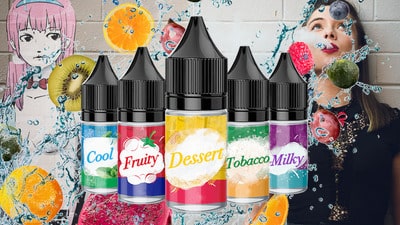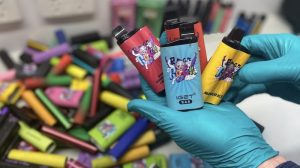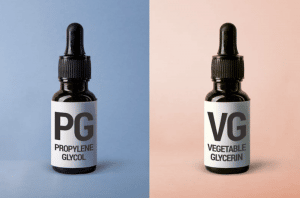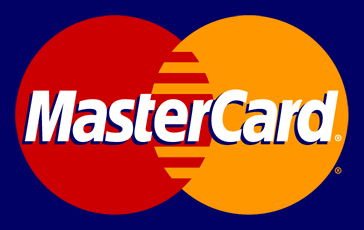WHAT ARE PG & VG?
What Is The Best Ratio For Me?
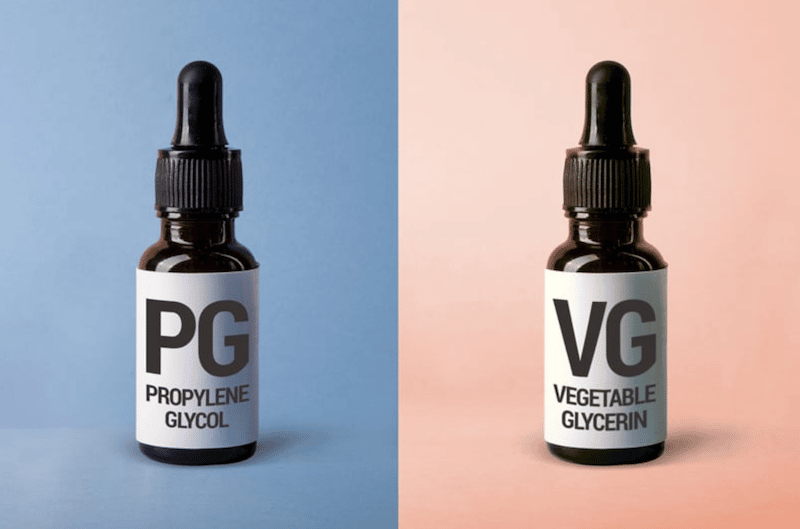
Almost every e liquid is made up of a combination of Propylene Glycol (PG) and Vegetable Glycerine (VG). Each adds different qualities to your eliquid and the ratio of each comes down to your personal preference and the device you are using.
WHAT ARE PG & VG?
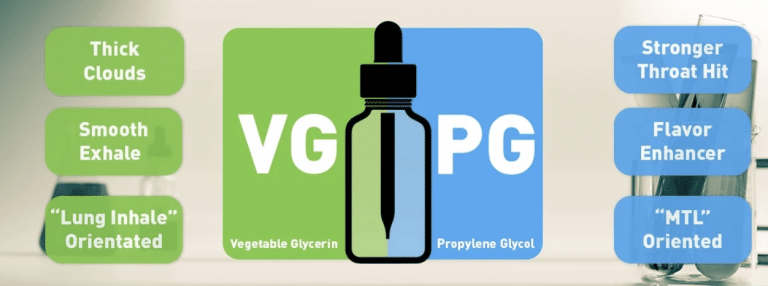
- PG and VG are the odorless liquids that are combined with flavour and nicotine (if added) to create e-juice.
- They form the basis of all modern day e-juices.
- They produce vapour when heated, which allows them to be inhaled.
- These two fluids have a different consistency to each other and a slightly different taste.
- They each have distinct mouth and throat sensations when vaped.
- Some vaping starter kit set-ups can only work with a certain level of PG and VG.
- PG and VG are not oils, and can’t cause any of the medical issues—like lipoid pneumonia—that inhaling actual oils can.
Each of these ingredients has an impact on the overall flavour profile of the juice. Both are food grade additives and are rated safe for consumption by the FDA. They are commonly used in everything from food, cosmetics, soaps and toothpaste amongst other things. It is important to note though, that in Vape eliquids the VG and PG should be Pharmaceutical grade, so of an even higher grade than food grade. We are diligent in that any ejuice sold by Australian Vaping Supplies contains only PG and VG that are of a USP Grade or BP Grade which means that a product is suitable for food, drug, or medicinal use, and is of high enough quality to be used for laboratory purposes where purity is essential.
Choosing the wrong PG/VG ratio can put first-timers off so be careful to choose the right level for your equipment.
Let's discover the differences....
Propylene Glycol
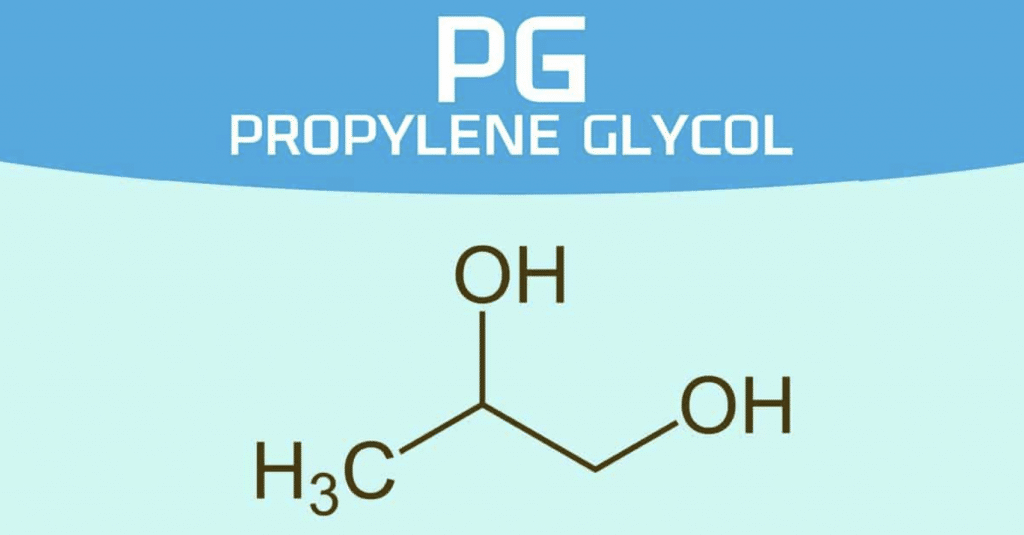
Is thinner than VG
Wicks quicker than VG
Gives you a bit of a throat hit (different than a nicotine throat hit)
Does not produce much in the way of clouds
Mouth To Lung orientated
Propylene Glycol (PG) is a thin liquid, used for a variety of things within multiple industries. Propylene Glycol can be found in various common household items. Amongst other things, these include: Toothpaste; Medical products; Beauty products; and Pharmaceuticals including inhalers for asthma.
PG is also extremely common in food items. Some of the most common foods you will find PG in are: dried soups, seasoning, marinades, salad dressings, baking mixes, fast foods, bread-based products, processed snack foods, flavoured popcorn, cake frosting/ icing sugar, Ice Cream, and food colouring.
Soft drinks, flavoured teas, powdered drink mixes and alcoholic beverages may also contain propylene glycol.
Chances are you’re already ingesting this product. It is a brilliant carrier for flavour.
In Eliquid, PG provides part of the throat hit that you’ll get upon inhaling your eliquid. PG does not create much in the way of vapour production. Being thin it is not as smooth on your throat than Vegetable Glycerine, which is useful for tobacco type blends. However, because PG is much thinner and soaks into the wick (cotton inside your coil) quicker, with a higher PG ratio, in a smaller coil, you’re less likely to run into problems with dry hits.
Vegetable Glycerine
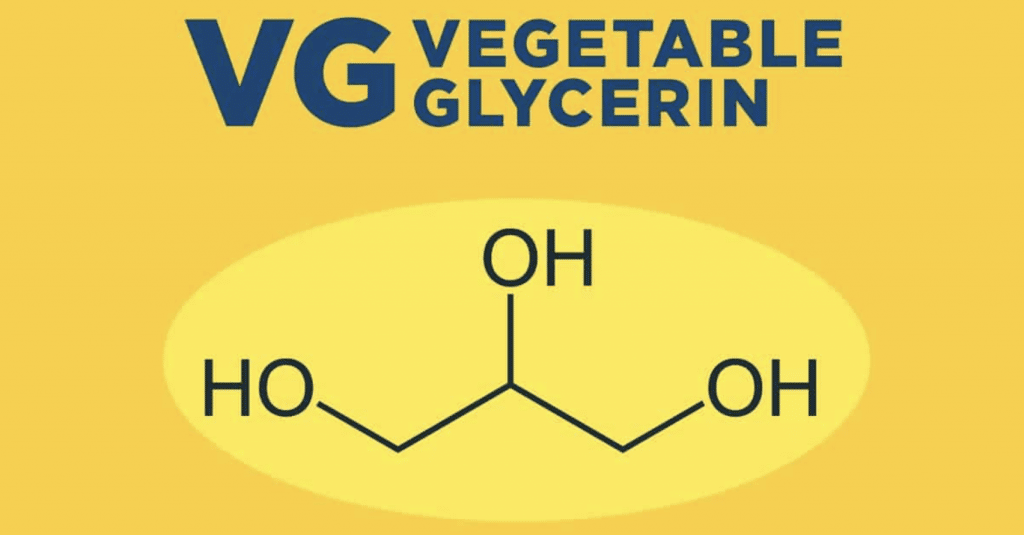
Is thicker than PG
Provides a smoother feeling to your inhale
Produces bigger clouds
Takes longer to soak into your coil
Direct To Lung orientated
Vegetable Glycerine (VG) is a thick viscous liquid, with a slightly sweet taste and is the consistency of syrup. Vegetable Glycerine is used in multiple industries. In the food industry Vegetable Glycerine is used as a sweetener or as a sugar replacement. It is also used in foods such as baked goods to increase the moisture content. It is also found in toothpaste and other oral hygiene products. In the beauty industry, vegetable glycerine is found in products such as makeup, lotions, aftershave, soap and deodorants. It is also widely used in the pharmaceutical industry for medications, topical lotions and cough syrups.
In Eliquid, Vegetable Glycerine provides smoothness to an e-liquid.
While VG may be lacking the throat hit, the biggest benefit is that it produces denser, thicker vapour clouds.
As such, it is used in higher ratios in more powerful devices (subohming).
Because VG is much more viscous than PG, it takes a lot longer for it to soak into the wick in your coil. This can cause problems when you vape a high VG content in a small coil and at lower wattages as the cotton just doesn’t have to time to resoak itself between puffs.
In many modern sub-ohm tanks, and especially in rebuildable atomizers, this doesn’t really matter. These devices have larger portholes and more effective wicking, so you won’t run into the same problems. However, if you’re using a smaller coils with small port holes, then high VG juices could lead to performance issues.
Tanks, Coils & The PG /VG Ratio
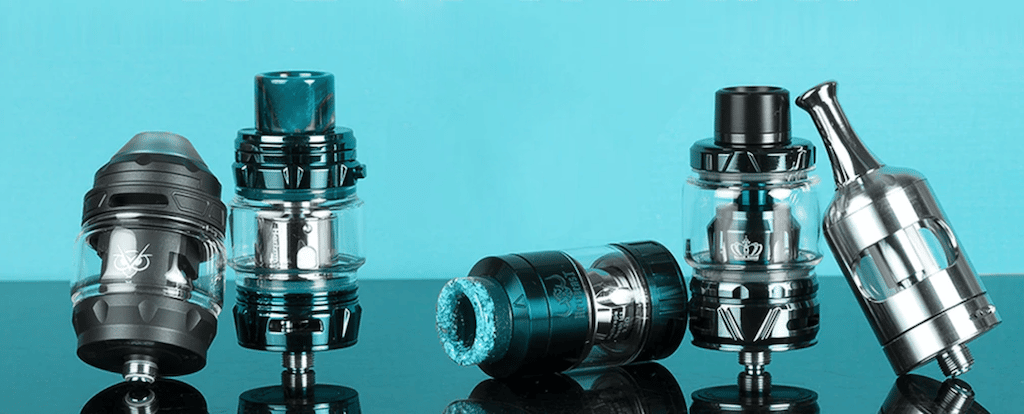
Subohm Tanks
If you Subohm or use a coil rated 0.9 ohm or lower, you’ll want a VG ratio of 70% or higher.
This is Because, Subohm coils are generally larger, they can take a lot more power and are designed to deal well with thicker VG juice. The closer you go towards a 50vg/50pg mix, the more likely you are to get leakages in a tank like this.
- 70% VG or higher
- VG provides a smoother vape at high wattages
- Higher wattage vaping (approx 40W and above) needs thicker juice & therefore a higher VG ratio, so it doesn’t leak
- Higher VG = thicker clouds
Mouth To Lung Tanks
If you Mouth to Lung vape or use a coil rated 1 ohm or higher, you’ll want a ratio of 50VG/50PG.
Mouth to lung coils are vaped at lower wattages. As such they cannot cope well with thick fluid; it can lead to unpleasant dry hits of burning cotton. Thicker juice takes time to soak into the coil’s cotton. If you are inhaling the juice constantly, you are drawing the juice out of the cotton. The thicker juice just wont have time to soak back into the cotton before your next inhale, therefore leading to a dry cotton hit. Higher VG content will also gunk these coils up quicker.
- 50VG/50PG
- This is a nice even ratio being not too thick for these smaller coils
- Smaller coils means too much thick VG will gunk them up
- Lower wattage vaping (approx 30W and below) needs a balanced VG/PG ratio
Pod Tanks
Pod’s will generally fall into the category of one of the two options above – that being Subohm vaping or Mouth to Lung vaping.
It really comes down to the wattage and the resistance range your coil uses. If you’re unsure, you can read the information on the coil itself or off the product page you purchased your vape from.
As a general rule of thumb:
- If 1 ohm or higher, use a 50VG/50PG Mix
- If under 1 ohm, you could try using either a 50VG / 50PG Mix or a 70GG/30PG Mix and see which one you like best.
It will be a bit of trial and error, as it is most likely to come down to the size of the coil and its juice ports which are the little holes on the sides of the coils that let the ejuice soak in. See the diagram below.
Even if you have a coil under 1 ohm which would usually take a 70% VG juice, some of these pod coils are very small with small amounts of cotton and small juice ports as per the Mouth To Lung wicking holes in the diagram below. They are also recommended to be vaped under 30watts. For a high VG juice, this all adds up to the VG taking a long time to soak into the cotton and to resoak itself after inhaling.
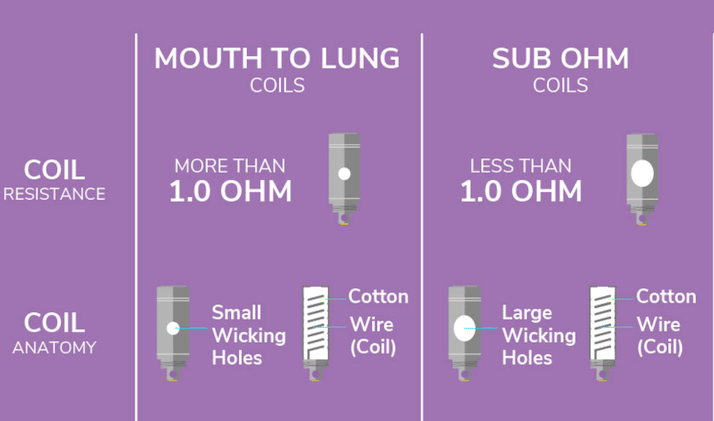
RATIOS

100VG
This mix can only be achieved with VG based nicotine and VG based flavour concentrates. It will be very smooth and have no throat hit. The main reasons to choose this ratio would be if you have an allergy to PG and or for competitive cloud chasing.
- Smooth- No throat hit (unless you have nicotine which will add the kick)
- Sweetness of VG will add to your flavour
- Thick long lasting clouds and vapour production
- Gunks up coils quicker
- Only suitable for coils under 1 ohm
70VG / 30 PG OR 80VG / 20PG
This ratio will give you a thicker liquid, ideal for sub ohm tanks and people who use RBAs. It’s very balanced and smooth, providing a bit of a throat hit, along with great vapour production.
- Smooth- gentle throat hit.
- Sweet which is great for fruit and dessert flavours
- Thick long lasting clouds and vapour production
- Great for sub ohm vaping
- Use if you have a Subohm Tank, or a higher powered Mouth to Lung Tank or Pod Mod system – think 30 – 35Watts and over.
- Best suited for coils under 1 ohm, otherwise they will gunk up very quickly
50VG / 50 PG
A 50/50 mix is a good starting point for new vapers while your experiment with your setups and get used to your preferences and what works best in your vape. This will work in most tanks and will wick properly. This is a balanced ratio that will give you a noticeable bite on the inhale. Being a thinner liquid it is best for Pod Systems and for Mouth to Lung Tanks.
- Medium throat hit
- Good flavour
- Medium vapour
- Use if you have a low powered pod system or mouth to lung tank
- Best for coils 0.8 ohm and over, however this ratio can be used for lower powered subohming. Lets say 40w’s and under. Just note, if using with coils under 1 ohm you will go through the liquid quicker as it is thinner and may make your tank prone to leaking.
30VG / 70 PG
This ratio incrementally increases the throat hit, while decreasing the vapour production. This would be on the thin side and give a harsh throat hit. While it can work we do not recommend it.
- Not very smooth
- Harsher throat hit
- Not a lot of vapour
- Thin and might make tanks prone to leak
- Best suited for coils over 1 ohm
100PG
We do not recommend a pure PG liquid, it will be incredibly harsh on the throat hit and very thin, so will not wick well in any atomizer.

